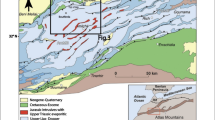Abstract
Examination of well logs leads to the observation that they exhibit characteristic behavior over a wide range of scales, differing from a foot to hundreds of feet. This behavior is not accounted for in conventional segmentation methods. The segmentation method that is proposed here aims to solve this problem. It is based on a multiscale representation of the well log. This is a representation of the well log at different levels of smoothness. The behavior of edges, which are associated with extrema of the first derivative, across scales is of great importance in the segmentation. Analysis of this behavior leads to a multiscale segmentation of the well log, in which a fine-scale segment is a part of one coarse scale segment only. In this way the geologist is able to analyze the log at different scales simultaneously. An extension of this approach is not to preserve all fine-scale information but to zoom in only on parts of the log where it is considered to be of interest.
Similar content being viewed by others
References
Alkemade, J. A. H., and Vermeer, P. L., 1989, Multiresolution and Time-Frequency Representations of Signals: Report 89–47, Delft University of Technology, 1989.
Babaud, J., Witkin, A. P., Baudin, M., and Duda, R. O., 1986, Uniqueness of the Gaussian Kernel for Scale-Space Filtering: IEEE Trans. PAMI-8, n. 1, p. 26–33.
Burt, P. J., and Adelson, E. H., 1983, The Laplacian Pyramid as a Compact Image Code: IEEE Trans. COM-31, n. 4, p. 532–540.
Butzer, P. L., and Nessel, R. J., 1971, Fourier Analysis and Approximation: Birkhauser Verlag, Basel.
Canny, J., 1986, A Computational Approach to Edge Detection: IEEE Trans. PAMI-8, n. 6., p. 679–698.
Collins, D. R., and Doveton, J. H., 1988, Colour Image Transformations of Wireline Logs as a Medium for Sedimentary Profile Analysis: Bull. Can. Petr. Geol., v. 36, n. 2, p. 186–190.
Goupillaud, P., Grossmann, A., and Morlet, J., 1984, Cycle-Octave and Related Transforms in Seismic Signal Analysis: Geoexploration, v. 23, p. 85–102.
Hawkins, D. M., and ten Krooden, J. A., 1979, A Review of Several Methods of Segmentation,in D. Gill and D. F. Merriam, Geomathematical and Petrophysical Studies in Sedimentology. Proceedings of the 10th International Congress on Sedimentology Jerusalem, 1978: Pergamon Press, Oxford.
Kerzner, M. G., 1986, Image Processing in Well Log Analysis: D. Reidel Publishing Company, Dordrecht.
Koenderink, J. J., 1984, The Structure of Images: Biol. Cybern., n. 50, p. 363–370.
Mallat, S. G., 1989, A Theory for Multiresolution Signal Decomposition: The The Wavelet Representation: IEEE Trans. PAMI-11, n. 7, p. 674–693.
Rosenfeld, A., Ed., 1984, Multiresolution Image Processing and Analysis: Springer, Berlin.
Wilson, R., and Spann, M., 1988, Image Segmentation and Uncertainty: Wiley, New York.
Witkin, A. P., 1984, Scale Space Filtering: A New Approach to Multiscale Descriptions,in S. Ullman and W. Richards (Eds.), Image Understanding: Northwood, N.J.
Yuille, A. L., and Poggio, T. A., 1986, Scaling Theorems for Zero Crossings: IEEE Trans., PAMI-8, n. 1, p. 15–25.
Author information
Authors and Affiliations
Rights and permissions
About this article
Cite this article
Vermeer, P.L., Alkemade, J.A.H. Multiscale segmentation of well logs. Math Geol 24, 27–43 (1992). https://doi.org/10.1007/BF00890086
Received:
Accepted:
Issue Date:
DOI: https://doi.org/10.1007/BF00890086




